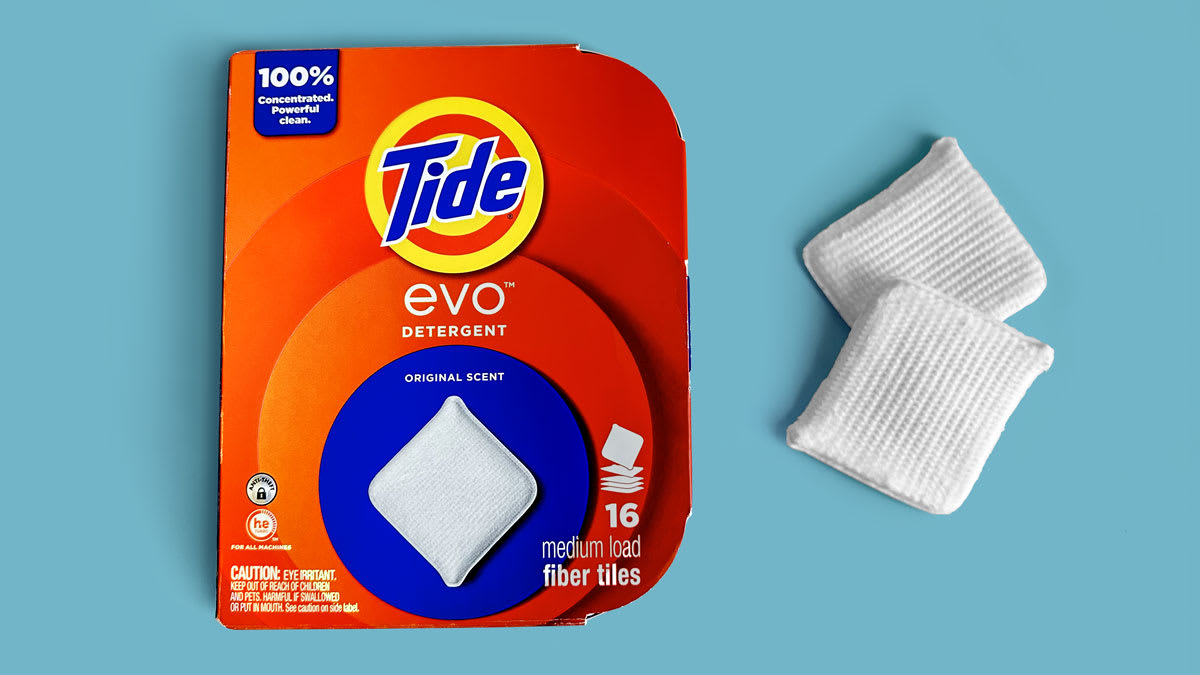Tide Evo Tile Laundry Detergent Review

In my experience, no laundry detergent brand has hit the sweet spot between efficiency, performance, convenience, and eco-friendliness (most either lack strong ingredients or use harsh chemicals). For example, Earth Breeze eco-friendly laundry detergent sheets came up short on cleaning performance in both our lab tests and a home evaluation. Could Tide Evo do better?
CR’s laundry lab currently rates dozens of liquid, pod, and sheet detergents, some of which claim to be gentle or sustainable. In our lab tests, we launder fabric swatches stained with blood, body oil, chocolate, coffee, dirt, grass, and salad dressing. Our testers use a colorimeter (a device that measures color intensity) to gauge how much of the stain remains on each laundered swatch.
When Tide Evo is widely available, we’ll buy it and put it through those same lab tests. For now, we simply wanted to see what it was like to do our own laundry with this new detergent form. Here’s how it went.
Upon unboxing, I was a bit overwhelmed by Tide Evo’s scent (more on that later). I don’t have allergies but I did sneeze a couple of times. Post-wash, it left my laundry with a nice bouquet (to me)—though it could be annoying (to you), depending on your preference.
Wash directions are inside the box lid, but using Tide Evo is as easy as using pods—just toss a tile into the drum before loading your laundry. They appeared to dissolve quickly, and didn’t produce a ton of suds (as seen through the window of Deb’s front-loader). That may be a good thing, as too many suds can cause a washer to use excess water. In all, we washed 12 loads with Tide Evo on a variety of settings, from normal to bulky to heavy soil—primarily with cold water as recommended, but also in warm and hot. In four large loads that included smelly towels, stained cottons, and white items washed in hot water, we used two fiber tiles. Here’s what we washed, and what we observed.
Comforter: First, I went big. I stuffed a black comforter into my 4.3-cubic-foot top-load agitator on the cold wash, bulky setting. Knowing this pushed the limits space-wise, I only used one tile and removed the comforter post-wash to check for residue. None was obvious, but I deployed the extra rinse cycle anyway, then dried it. It came out clean, with a faint whiff of fragrance.
Mixed loads: Deb washed a mixed load (including jeans smeared with garden dirt) in warm water. Tide Evo removed the dirt stains and “everything else came out as clean as when I use the usual Tide or Persil liquid,” she says. My two mixed loads, washed in cold water, also cleaned well, stains and all.
White clothes: We both washed whites (bath and hand towels, socks, etc.) in hot water, tossing in a few dingy, soiled sports socks for good measure. Tide Evo reduced the heavy soil to gray, but the results fell short of bright white, even after Deb tried a two-tile follow-up wash.
Stained fabrics: I intentionally stained a small load of older, dark cottons (boxers, shorts and T-shirts) with a dab of olive oil, soy sauce, and even risky raspberry syrup. I tossed in a salad dressing-stained white shirt for kicks. (I know, I know—never mix colors. Sorry, Mom.) To my surprise, most stains were removed on the first wash with one tile. There was one exception—an accidental olive oil spill from my daughter’s graduation tapas dinner stained my favorite black polo. I called in two-tile reinforcements for a bigger dark cotton load and that cycle finished the job. (But always inspect closely before drying so stains don’t lock in.)
Sweaty workout clothes: After a long walk on a hot day, I threw my sweaty shirt, shorts, and socks into a small cold load to see if Tide Evo was up for the job—it was. Deb, a jogger, washed colorful synthetic exercise clothes in cold water. To her surprise, it all came out clean and fresh-smelling. Not an easy task since smelly synthetics are hard to clean—their moisture-wicking technology can trap sweat and body odors deep in fabrics. (We advise washing them on the delicate cycle in either warm water or the hottest water the label recommends before drying on low heat.)
Source link


